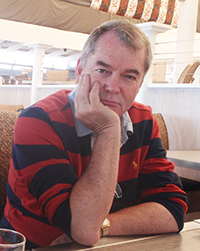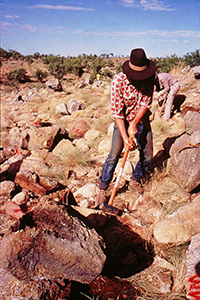
Paleontologist Michael Archer, Fellow of the Academy since 2002, has over 30 years’ experience in the evolutionary history of marsupials and monotremes.
It’s hard to single out one thing, but one was the 1983 discovery in north-western Queensland of one of the richest fossil deposits in the world. The area they were found in is now the Riversleigh World Heritage property. I was standing on a rock trying to spot a colleague who was carrying our maps. When I looked down, I realised that the rock I was standing on was bristling with the fossilised jaws, skulls and teeth of more than 35 new kinds of mammals. They were 15 million year old and the first of more than 200 new fossils mammals subsequently found at Riversleigh. It was the kind of fossil deposit we had all dreamed of finding, and suddenly here it was — a very exciting moment!

Palaeontology will be increasingly assisted by new technology such as remote sensing using satellites but still dependent on ARC-funding, expeditions, hard work on the ground and serendipity. While we continue to find dozens of new often extraordinary kinds of extinct animals every year, there will be new ways to analyse these fossils and help reconstruct their life styles and relationships, ancient environments, changing climates and changing fortunes through time. Improvements and new discoveries involving dating technologies will give us ever better understanding about when and how our unique Australian biotas transformed from ancient times to become the way we see them today. I am also convinced that within the next 50 years we will be able to use new technology and new understanding to bring some extinct species back to life.
Since returning to Australia (I was born here) in 1967, I’ve been fascinated by everything to do with Australia’s unique native mammals — their modern biodiversity, biology, behaviour and of course all aspects of their history, which documents how they became what we see today. Because there are as many or more families of marsupials and monotremes that are extinct than survive, it would be very hard not to be at least as fascinated with the often bizarre extinct forms such as marsupial lions as with modern groups such as thylacines and marsupial moles. Since its separation from Antarctica 38–35 million years ago, Australia has been host to a menagerie of mammals which collectively are just as intriguing as those from the rest of the world. Of course we are also fascinated to explore the threads through time that link some of these lineages into the biotas of Antarctica and South America. Finding platypuses 61 million years old in Argentina was a real eye-opener of this kind.

Many individuals, from professionals who took time out to mentor me when I was a kid about the fossils I collected, to profoundly inspirational teachers who stretched my mind, such as Mr Smith who taught me philosophy at Princeton University, gods in my field like George Gaylord Simpson who took a personal interest in my PhD research, intellectually eclectic colleagues like David Ride who inspired and assisted my early work with living as well as fossil marsupials, brilliant innovators like Craig Venter and Bob Lanza who encouraged me to try what others said was a waste of time (recovering the DNA of extinct animals), awesome science communicators like David Attenborough, Robyn Williams and Paul Willis, who inspire millions to catch the ‘science bug’, vital science writers such as Bob Beale, Mary White and Leigh Dayton who ‘translate’ often jargon-riddled discoveries into words that can be understood by everyone, visionary individuals such as Dick Smith, Phil Creaser, Gary Johnson and Ken Pettit who help others to become explorers at the unknown edges of science, professionals in their fields such as Suzanne Hand and Henk Godhelp who are not only leaders but spend enormous amounts of time making sure the public understands why what they are doing is so important and many others. But perhaps the most inspirational to me are those professionals as well as members of the public who dare to be really different, who are willing to take personal risks to test the limits of the unknown, no matter what they do for their day job.
Growing up in the Appalachia in the US meant I became quite good at playing the five-string banjo and making moonshine. But my interests in science tended to isolate me from kids of my own age, so most of my memories from those days relate to forays on my own into the natural biological and geological worlds of the Catskills Mountains. Fortunately, shortly after Sputnik beeped its way over the US in 1957, scaring the government of the day into realising that they were falling behind the Russians in science, a program of science fairs was initiated at local and national levels to build up interest in excelling in science. These for me were a wonderful opportunity to not be embarrassed about being interested in science. I could mingle with other kids my age who were similarly driven. It’s the reason I would love to see a similar national program developed and funded in Australia. When governments clearly demonstrate through programs of this kind that they value kids focusing their lives on science, many step up to that plate and science magic happens.
© 2025 Australian Academy of Science